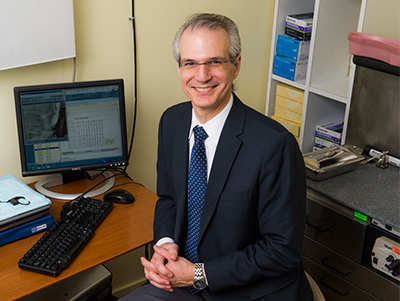Pioneering the Understanding & Treatment of Hearing Loss
Our centers for hearing loss and other disorders of the ear are led by the nation’s leading otology and neurotology specialists. We care for patients with ear, hearing, balance, and related skull base disorders, including tinnitus, dizziness, infectious and inflammatory diseases of the ear, facial nerve disorders, cholesteatomas, congenital malformations of the ear, and tumors of the ear, acoustic nerve, and skull base. Both campuses offer comprehensive audiology services, including central auditory processing evaluations, vestibular assessments, and electrophysiological testing. Patients benefit from customized hearing aid fitting, including bone-anchored hearing aids. Our clinical services are bolstered by robust basic science and clinical research aimed at clarifying the roots of hearing loss and improving treatments.

Justin S. Golub, MD, MS, otologist/neurotologist,
NewYork-Presbyterian/ColumbiaUnderstanding age-related hearing loss (ARHL). Columbia University researchers are leaders in the understanding of ARHL and its relationship to other variables. They have demonstrated links between ARHL and depression, cognitive impairment, and dementia. Moreover, preliminary brain imaging studies show smaller brain volumes as well as white matter tract dysfunction in adults with hearing loss. These findings suggest that prevention or treatment of hearing loss may be an effective strategy for managing depression and cognitive impairment. Our investigators have also created innovative big-data analytical models to show that older age is not a significant predictor of cochlear implant performance when controlling for confounders.

George Alexiades, MD, Director, Cochlear Implant Center,
NewYork-Presbyterian/Weill CornellPredicting hearing aid success. Weill Cornell Medicine investigators are exploring ways to predict how well individuals with hearing loss will fare once they begin using hearing aids. Patients do not always do as well as doctors would like, so researchers would like to identify markers of hearing aid success and failure.
Pursuing gene therapy. NewYork-Presbyterian/Columbia is one of four centers in the world conducting a clinical trial in which cellular regeneration is being used to treat hearing loss. Most causes of hearing loss are due to the death of inner ear hair cells. The study is assessing an investigational drug called CGF166 containing a gene that has been shown in laboratory studies to produce hair cells.
Clarifying auditory mechanics. Scientists at Columbia University are exploring the workings of the "cochlear amplifier," the cell-based mechanism for boosting sensitivity and frequency selectivity in the inner ear. They are also seeking to understand the basis of high-fidelity transmission of the middle ear, and have published several papers in both areas. Researchers are also studying new ways to stimulate the inner ear as an alternative to cochlear implants and exploring the genetic basis of noise-induced hearing loss.
Improving cochlear implants. To address mechanical problems involving cochlear implants, Columbia University scientists developed a nontraumatic hydro-assisted method using viscous fluid to "carry" the implant into the cochlea, thereby preventing damage. They also designed an intracochlear microphone to serve as a component of a cochlear implant.
Improving hearing after acoustic neuroma treatment. Many patients with acoustic neuroma experience hearing loss in the affected ear. While contralateral rerouting of sound hearing aids—bringing sound from the deaf to the hearing ear—bone-anchored hearing aids, and cochlear implants are effective options for hearing rehabilitation, some patients forego these treatments, choosing instead to make modifications for the rest of their lives to listen only through the “good ear.” Weill Cornell Medicine investigators are conducting research to understand why acoustic neuroma patients make the choices they do after treatment—such as the choice of a particular hearing rehabilitation technique versus the decision to go without—with the goal of optimizing hearing after surgery.

Samuel H. Selesnick, MD, Vice Chairman, Department of
Otolaryngology, Weill Cornell MedicineDrug delivery to the cochlea. Current methods to administer drugs to the cochlea to treat hearing loss, vertigo, and tinnitus are limited by an inconsistent rate of molecular transport across the round window membrane (RWM). Our researchers have devised a novel way to introduce one or more microscopic perforations through the RWM using a 3D-printed microneedle to enhance the rate and reliability of drug diffusion; it is being assessed in a laboratory model.

Anil K. Lalwani, MD, Co-Director, Cochlear Implantation Program,
NewYork-Presbyterian/ColumbiaEnhancing music enjoyment in cochlear implant users.
Many users of cochlear implants struggle with music perception, particularly with pitch-based and melodic musical elements. Columbia University investigators have found that re-engineering music to reduce its complexity by reducing harmonics and reverberation time improved music enjoyment for cochlear implant users.Cost-effectiveness studies. Our researchers have conducted studies to delineate the most cost-effective approaches to evaluating patients with sensorineural hearing loss and vertigo.
Selected Publications
Age-related hearing loss and its association with depression in later life. American Journal of Geriatric Psychiatry. 2018;26(7):788-96.
Sensation and psychiatry: linking age-related hearing loss to late-life depression and cognitive decline. American Journal of Psychiatry. 2018;175(3):215-24.
Brain changes associated with age-related hearing loss. Current Opinion in Otolaryngology and Head and Neck Surgery. 2017;25(5):347-52.
Observed hearing loss and incident dementia in a multiethnic cohort. Journal of the American Geriatrics Society. 2017;65(8):1691-1697.
Assessing cochlear implant performance in older adults using a single, universal outcome measure created with imputation in HERMES. Otology & Neurotology. 2018;39(8):987-994.
A novel perfusion-based method for cochlear implant electrode insertion. Hearing Research. 2014;314:33-41
An intracochlear pressure sensor as a microphone for a fully implantable cochlear implant. Otology & Neurotology. 2016;37(10):1596-1600.
Cost-effective analysis of unilateral vestibular weakness investigation. Otology & Neurotology. 2015;36(2):277-81.
Cost analysis of asymmetric sensorineural hearing loss investigations. The Laryngoscope. 2010;120(9):1832-36.
In vitro perforation of the round window membrane via direct 3-D printed microneedles. Biomedical Microdevices. 2018;20(2):47.
Reduction of the harmonic series influences musical enjoyment with cochlear implants. Otology & Neurotology. 2017;38(1):31-37.
Reverberation time influences musical enjoyment with cochlear implants. Otology & Neurotology. 2015;36(2):e46-50.



